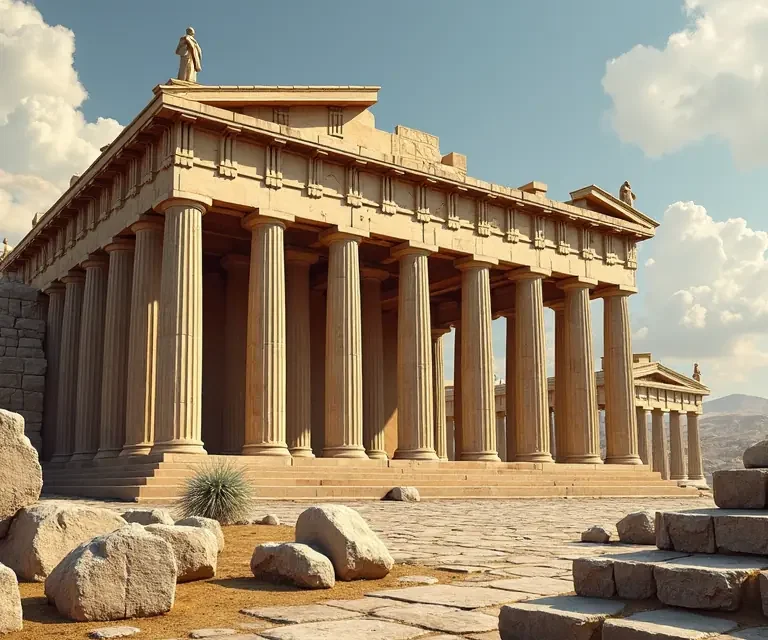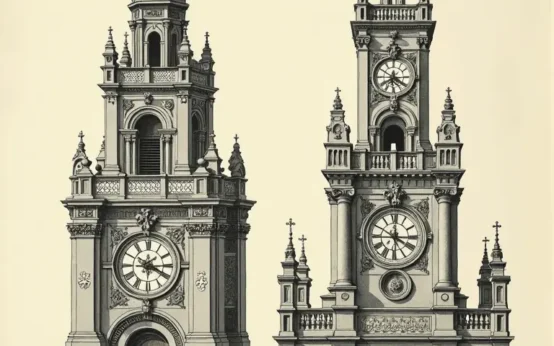For millennia, humans have strived to create structures that are not merely functional, but also beautiful. From the majestic pyramids of Egypt to the intricate temples of Greece and the soaring cathedrals of Europe, ancient builders seemed to possess an innate understanding of proportion and harmony. But was this understanding purely intuitive, or was it rooted in a deeper, mathematical framework? This article delves into the fascinating world of ancient building proportions, exploring the mathematical principles that underpinned these architectural marvels, and the cultural beliefs that shaped their design.
The Seeds of Proportion: Early Civilizations
The earliest evidence of deliberate proportion in architecture dates back to ancient Egypt, around 3000 BCE. The pyramids, particularly the Great Pyramid of Giza, are often cited as examples of sophisticated mathematical knowledge. While the exact methods used by the Egyptians remain a subject of debate, it’s clear they weren’t simply stacking stones haphazardly. The slope of the pyramid’s sides, for example, is remarkably consistent, and some researchers believe it’s closely related to Pi (π), the ratio of a circle’s circumference to its diameter. This suggests an early grasp of geometric principles. However, attributing a conscious use of Pi is contentious; the consistent slope was likely achieved through practical methods and carefully maintained angles during construction.
The Egyptians also employed a system of proportional measurement based on the royal cubit – the length of the forearm from the elbow to the tip of the middle finger. This unit was used to standardize dimensions across building projects, ensuring a degree of consistency and order. Furthermore, the ‘seked’ – a measure of slope – allowed builders to precisely control the angle of pyramid sides.
The Golden Ratio: A Divine Proportion?
Perhaps the most famous mathematical concept associated with ancient architecture is the Golden Ratio, often denoted by the Greek letter phi (φ), approximately equal to 1.618. This irrational number appears repeatedly in nature – in the spirals of seashells, the branching of trees, and the arrangement of sunflower seeds. The question is, did ancient builders consciously incorporate the Golden Ratio into their designs?
The Parthenon in Athens (447-432 BCE) is frequently cited as an example. Measurements of the Parthenon’s facade reveal dimensions that approximate the Golden Ratio. The ratio of its height to width, and the arrangement of its columns, seem to align with this ‘divine proportion’. However, it’s important to approach these claims with caution. Some scholars argue that the apparent presence of the Golden Ratio is a result of selective measurement and interpretation, and that the Greeks were more interested in simple, whole-number ratios.
Regardless of whether the Greeks deliberately employed the Golden Ratio, their architecture was characterized by a sophisticated understanding of harmonic proportions. They favored ratios like 3:2, 4:3, and 5:4, which were considered aesthetically pleasing and visually balanced. These ratios were believed to create a sense of harmony and order, reflecting the Greek philosophical ideal of a well-ordered universe.
The Roman Contribution: Practicality and Grandeur
The Romans, renowned for their engineering prowess, adapted and expanded upon the architectural traditions of the Greeks. While they appreciated the aesthetic principles of Greek architecture, they placed a greater emphasis on practicality and grandeur. Roman architecture is characterized by its massive scale, its use of concrete, and its innovative structural designs, like arches, vaults, and domes.
While the Romans didn’t necessarily prioritize the Golden Ratio to the same extent as the Greeks, they still employed proportional systems to ensure structural stability and aesthetic appeal. The Roman architect Vitruvius, writing in the 1st century BCE, outlined principles of proportion based on the human body. He believed that perfect architecture should reflect the proportions of a well-formed human being, creating a sense of harmony and balance. Vitruvius’s ideas had a profound influence on Renaissance architects, who sought to revive the classical traditions of Greece and Rome.
Medieval Marvels: Gothic Cathedrals and Sacred Geometry
The medieval period witnessed the rise of Gothic architecture, characterized by its soaring heights, pointed arches, ribbed vaults, and stained-glass windows. Gothic cathedrals, like Notre-Dame de Paris and Chartres Cathedral, are not only architectural masterpieces but also expressions of religious faith and philosophical thought.
Gothic architects believed that geometry was a divine language, a way to understand the order and harmony of the universe created by God. They employed complex geometric principles, including the Golden Ratio and other harmonic proportions, to design their cathedrals. The height of the nave, the width of the transepts, and the placement of the windows were all carefully calculated to create a sense of spiritual elevation and awe. The use of repetitive geometric patterns also symbolized the infinite nature of God.
Furthermore, the layout of Gothic cathedrals often incorporated symbolic numbers and geometric shapes. For example, the number three, representing the Holy Trinity, was frequently used in the design of the facades and the arrangement of the chapels. The circle, representing eternity, was often incorporated into rose windows and other decorative elements. This interplay between mathematics, symbolism, and religious belief is a hallmark of Gothic architecture.

Beyond the West: Proportions in Other Cultures
The fascination with proportion and harmony wasn’t limited to Western civilizations. Ancient cultures around the world developed their own unique systems of proportional measurement and architectural design.
In India, ancient temples were often designed according to the principles of Vastu Shastra, a traditional system of architecture that emphasizes harmony with nature and the cosmos. Vastu Shastra prescribes specific proportions and orientations for buildings, based on the cardinal directions and the influence of the planets. The use of squares and circles, representing the cosmic order, is a common feature of Indian temple architecture.
In China, traditional architecture is based on the principles of Feng Shui, which seeks to harmonize buildings with their environment. Feng Shui emphasizes the importance of balance, symmetry, and the flow of energy. Chinese buildings often feature courtyards, gardens, and carefully positioned elements to create a sense of tranquility and harmony. The use of modular construction, based on the cai-cun unit, ensures consistency and proportionality.
The Inca civilization in South America also demonstrated a sophisticated understanding of proportion and geometry in their stonework. The precise fitting of stones, without the use of mortar, is a testament to their engineering skills. Inca structures, like Machu Picchu, are often aligned with astronomical events, suggesting a connection between architecture, cosmology, and religious belief. The deliberate use of trapezoidal shapes, providing stability against earthquakes, also illustrates their practical understanding of geometry.
The Enduring Legacy: Mathematical Principles in Modern Architecture
The mathematical principles that underpinned ancient architecture continue to influence modern design. Architects today often employ the Golden Ratio, Fibonacci sequences, and other harmonic proportions to create buildings that are aesthetically pleasing and visually balanced. However, modern architects also have access to new technologies and materials, allowing them to explore more complex and innovative designs.
The principles of sustainable design, for example, often incorporate geometric principles to optimize energy efficiency and reduce environmental impact. The use of fractal geometry, inspired by patterns found in nature, can create buildings that are both visually striking and functionally efficient. The exploration of parametric design, using algorithms to generate complex forms, is another example of how mathematics is shaping the future of architecture.
The Psychology of Proportion: Why Do We Find Certain Ratios Appealing?
Beyond the purely mathematical and structural aspects, there’s a psychological dimension to our appreciation of proportion. Why do we consistently find certain ratios, like the Golden Ratio, aesthetically pleasing? Some theories suggest that our brains are wired to recognize and prefer patterns that are found in nature, associating them with health, vitality, and beauty. This preference may be rooted in our evolutionary history, where recognizing patterns was essential for survival.
Furthermore, the principles of Gestalt psychology suggest that our brains tend to perceive objects as unified wholes, rather than as isolated parts. Harmonic proportions can create a sense of visual coherence and balance, making objects more easily processed and understood by the brain. This sense of coherence can evoke positive emotions and create a feeling of well-being. This explains why a well-proportioned space feels comfortable and inviting, while a disproportionate one can feel unsettling or chaotic.
The Intersection of Math, Culture and Belief
Ultimately, the math behind ancient building proportions isn’t just about numbers and formulas. It’s a reflection of the cultural beliefs, philosophical ideas, and religious values of the societies that created these structures. The deliberate use of proportion was often seen as a way to connect with the divine, to express harmony with the cosmos, and to create spaces that were both functional and spiritually meaningful.
The study of ancient building proportions offers a fascinating glimpse into the minds of our ancestors, revealing their ingenuity, their creativity, and their deep understanding of the world around them. It reminds us that mathematics is not merely an abstract discipline, but a powerful tool that has shaped human culture and continues to inspire us today. Exploring these historical connections can also provide insights into other areas, such as the underlying principles of humor, which also relies on patterns and expectations.
Further Explorations
The pursuit of understanding ancient symbolism doesn’t stop with architecture. Consider exploring the symbolism embedded in knots, or the precision found in seemingly ephemeral arts like shadow puppetry. The dedication to detail and precision echoes the careful calculations of ancient builders. The artistry of calligraphy, and even the intricate mechanisms of antique locks demonstrate a similar human impulse towards order and beauty. These seemingly disparate fields all reveal a deep-seated human need to find – and create – harmony in the world.


 The Curious Acoustics of Historical Echo Chambers: Resonance, Ritual, and Revelation
The Curious Acoustics of Historical Echo Chambers: Resonance, Ritual, and Revelation  The Curious Calculus of Clock Towers: Time, Geometry, and Civic Pride
The Curious Calculus of Clock Towers: Time, Geometry, and Civic Pride  The Surprisingly Consistent Geometry of Traditional Origami: Beyond Folds, A History of Mathematical Precision
The Surprisingly Consistent Geometry of Traditional Origami: Beyond Folds, A History of Mathematical Precision  The Unexpectedly Consistent Math Behind Musical Instrument Tuning: Harmonics, Ratios & Perfect Pitch
The Unexpectedly Consistent Math Behind Musical Instrument Tuning: Harmonics, Ratios & Perfect Pitch  The Surprisingly Consistent Geometry of Bird Nests – Nature’s Architectural Blueprints
The Surprisingly Consistent Geometry of Bird Nests – Nature’s Architectural Blueprints  The Surprisingly Consistent Math Behind Musical Harmony
The Surprisingly Consistent Math Behind Musical Harmony